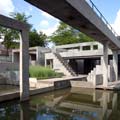
Riverbank Park
Flint, MI
The most important thing about designing is to generate creativity in others, and to be inclusive – to include the needs and experiences of people interacting with the environment, and to let them be part of its creation. — Lawrence Halprin
History
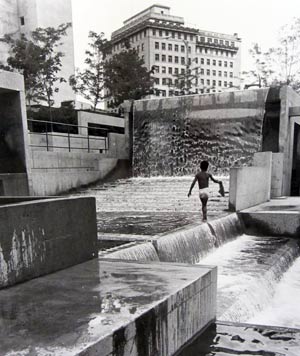
Photo courtesy Cade Surface.
In the early 1970s the office of Lawrence Halprin & Associates was commissioned to produce a design for a narrow swath of land along the banks of the Flint River in Flint, Michigan, prone to flooding. Already, the subject of an Army Corps of Engineers flood control project, Halprin’s firm was brought on to create a linear public park based on the Army Corps of Engineers requirements.
The Army Corps of Engineers, a branch of the US Army, was established in 1802 to provide infrastructure-related design and engineering services for the United States Government. Since its creation the Corps has played an increasingly significant role in the design and construction of civil and military projects within the United States and abroad. In the 1900s the Corps was tasked with designing dams and hydroelectric plants as well as providing flood remediation strategies along the nation’s waterways. As a result, the design of public spaces throughout the United States has been impacted by the work of the organization.
In 1974, after the Halprin office was already well along in the design for the Flint project, architect Steven Holl was hired as a model maker in the office and tasked with creating a model of Riverbank Park. Holl later led the production of construction drawings, working with Halprin employees Satoru Nishita and John Cropper to see the project to fruition in the late 1970s. The final design featured a series of five interconnected block-long parks, an amphitheatre, market stalls, and large-scale water features that included an animated fountain, a cascading wall of water powered by an Archimedes Screw and a series of canals. Like many of Halprin’s other designs, the park is separated from the surrounding urban environment by terraced landscaping.
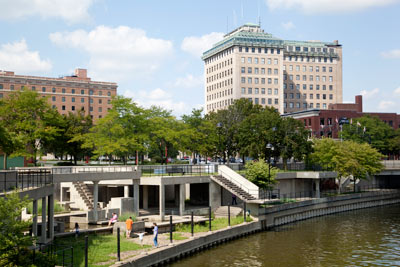
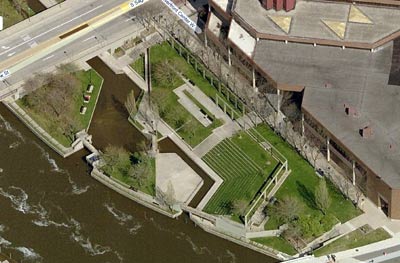
(top) Photo © Paul-David Rearick; (bottom) Photo courtesy
Cade Surface.
An early example of green infrastructure, the park’s water features utilized a combination of water from the Flint River and storm water runoff from the surrounding site. Elements of the park still continue to collect runoff and convey it to the canal system. The park, a significant mid-century modern addition to Flint’s downtown area, received an ASLA Honor Award for Parks & Recreation Planning in 1982.
The design for Riverbank Park illustrated the initial steps, concepts, and elements of park design and the 'landscape-as-infrastructure' approach to design that practitioners like Halprin helped to pioneer. It not only used an Army Corps of Engineers flood control project as its foundation, but also deliberately provided access to and connections with the river itself, seeking to represent and celebrate the natural function and form of the river in its urban setting.
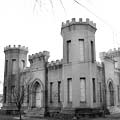
Patron
Army Corps
of Engineers
Threat
Today, the design integrity of Riverbank Park is threatened on two main fronts. First, the Hamilton Dam, built in 1922, which rests at the head of the park, is at imminent risk of collapse. Consequently, the city maintains low-flow conditions up and downstream leaving Riverbank Park dry. The park’s channels, pools, and water features—designed to utilize the river—remain empty, unattractive, and dangerous with portions of the park’s infrastructure starting to collapse (some plans would replace the park’s distinctive island features with flat lawns). Second, Riverbank Park is the victim of conflicting redevelopment agendas, the result of long-term deferred park maintenance, which have led the park to fall into disrepair. While redevelopment options have been proposed that respect the key elements of the space—including examples of visible and green infrastructure, programming, and connections with the greater downtown area—the current plan fails to take into consideration past community and stakeholder engagement.
Additionally, threats to the site are ongoing and without any efforts by the city to reinforce the channel walls or repair/replace the failing dam, the channel walls are becoming increasingly weak, with a few sections visibly separating and falling in. If awarded, grant funding that was pursued to pay for filling in the channels would be disbursed in late 2012 with work most likely beginning in summer 2013.
How You Can Help
Riverbank Park is an important part of Michigan’s Modernist landscape architectural heritage and the public’s role in its preservation as a regionally distinct public space is paramount. It is important that residents let officials know that the park is an appreciated part of the community, and should not be altered without significant public consideration.
Further, the park would benefit from the involvement of a singular organization that represents the broadest possible range of constituents and stakeholders – “Friends of Riverbank Park” – could contribute to a lasting, even-keeled, and progressive vision of the park and its future. It is hoped that such an organization would aid efforts to enliven, enrich, and improve this nationally significant park that represents a rare and revolutionary collaboration between the Army Corps of Engineers and landscape architects Lawrence Halprin and architect Steven Holl.
Learn More
Riverbank Park
Saginaw Street
Flint, MI 48502


